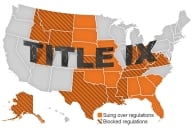You have /5 articles left.
Sign up for a free account or log in.
The good news is, Vermont is backing away from the plan to close Northern Vermont University.
The bad news is, it hasn’t come anywhere close to addressing the problems that made closure seem necessary.
Stay tuned …
--
I’m still scratching my head at the pronouncement from Mitch Daniels, the president of Purdue University, that when Purdue reopens, it will try to minimize contact between people under 35 and people over 35. His argument, apparently, is that the under-35 crowd is much less likely to die from exposure to the virus.
It’s one of the weirder presidential letters I’ve seen, and I’ve been doing this awhile.
Most faculty and staff are over 35, often by a fair bit. As a marketing appeal, “minimal contact with faculty!” seems like a nonstarter.
There’s a basic issue of age discrimination, of course. The courts have long held that discrimination “for their own good” isn’t allowed -- anyone remember the Johnson Controls case? -- but the courts have shifted so dramatically over the last few years that I wouldn't necessarily expect them to respect, you know, precedent. In normal times, I’d expect a move like that to be laughed out of court, but these aren’t normal times.
In this case, though, even the “for their own good” argument doesn’t really work. COVID-19-related fatality rates don’t jump notably at 35, or even near it. In addition to being illegal and paternalistic, it’s also based on a false premise. That adds to the weirdness. It would be like banning Capricorns or left handers. Even if you could, why would you? What would be the point?
I’ve seen suggestions on Twitter that it’s laying the groundwork for an assault on tenure, since tenured faculty are mostly over 35. Maybe. I’ll try another theory.
The age cutoff is a distraction from the actual point of the letter, which is to get the students to come rushing back in droves. Daniels has made waves by keeping tuition flat for years, hoping that nobody would notice that he’s doing it through growth. If the growth stops or reverses, the whole thing comes crashing down. But just telling folks to jump back in when the virus situation is so unsettled is awkward at best. When you can’t win the argument, change the subject; get folks talking about age cutoffs, and you’ve shifted the focus from whether it makes sense to have hundreds of students at a time living in the same building with the same HVAC system.
--
For a heartening contrast, I recommend Gianpiero Petriglieri’s piece in the Harvard Business Review on crisis leadership. It draws heavily on the work of Donald Winnicott in emphasizing the importance of “holding” -- giving a sense of value and safety to everyone -- in laying the groundwork for collective action.
As Petriglieri has it, people need to feel like the situation is in hand before they’ll leap into action. That means needing a sense of connection and validation, and the security that comes from hearing the ring of truth. Sometimes that truth is really unpleasant -- he gives the example of the BP oil spill -- but even then, people respond better to statements that fit with observed reality than they do to hollow optimism. Vision matters, but without connection, it isn’t compelling enough to move people.
It’s not a perfect theory -- too much holding can lead to complacency or suffocation -- but there’s something real about it. And it looks very different from much of our current culture.
Holding is about unifying. It’s not about dividing internally or finding scapegoats. It’s not about mock executions of campuses or disparagements of anyone old enough to remember rotary phones. It’s about consistency.
Worth the read.







